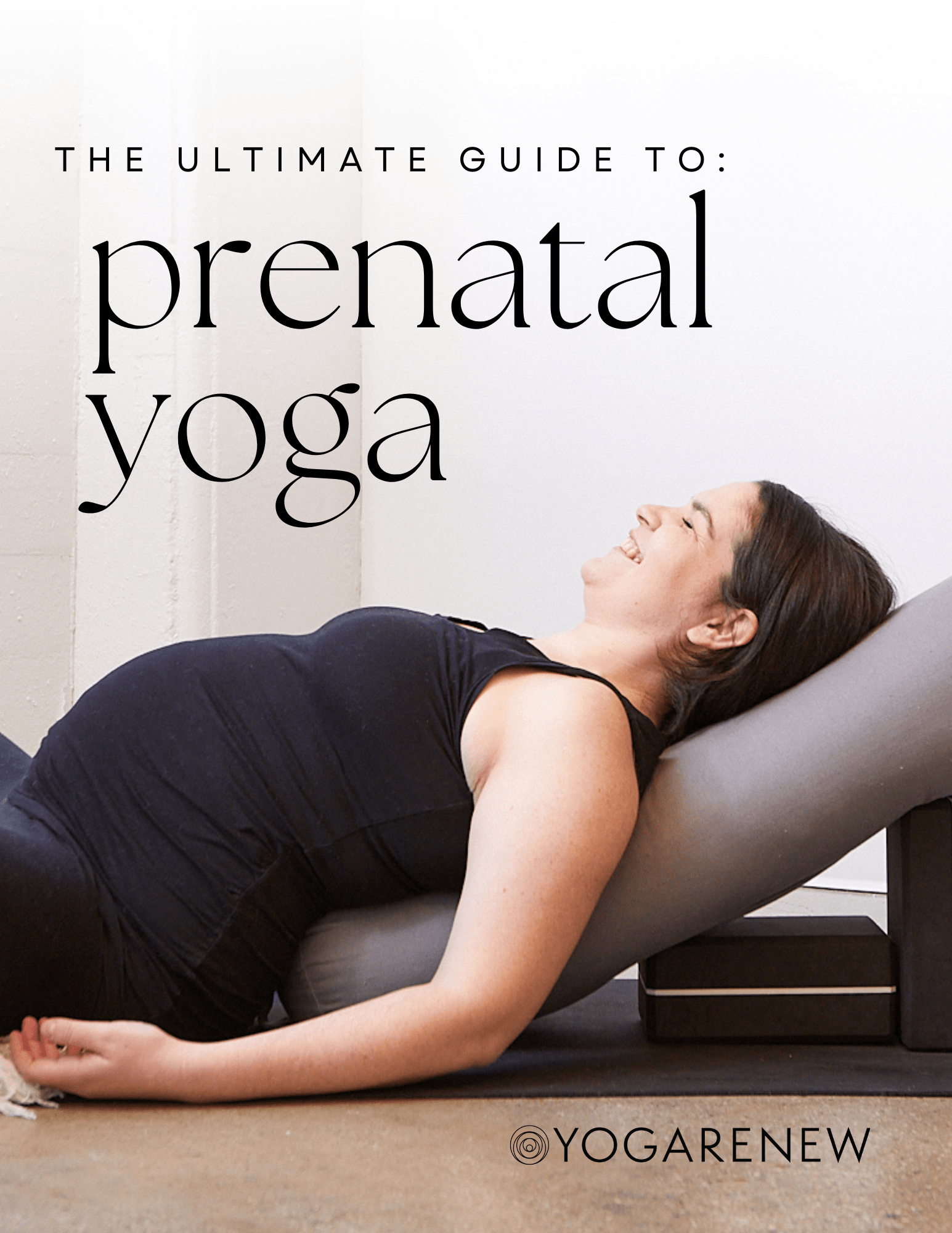
There are a lot of misconceptions when it comes to prenatal yoga. Mostly due to the variability of the methodology in which it is taught. I have made a clear choice when I began teaching prenatal yoga to always offer a fully rounded yoga class to my students, meaning, I like my prenatal classes to resemble a typical vinyasa class as closely as possible… with proper modifications and adjustments of course!
There is a time and a place for modifications and adjustments but those should not feel like a dilution of the yoga practice itself but rather a way in which the student can still show up on their mat, take what they need and leave what they don’t under the guidance from a teacher. In this article, we’ll dive into how I structure a full, well-rounded prenatal class as well as important things to pay attention to when guiding pregnant people in a yoga class.
Prenatal Yoga Class Structure
We always start class with a circle time during which everyone is invited to share their name, how far along they are and special requests for the class. This is the biggest difference between my regular classes and my prenatal classes. I do not come prepared with a sequence but rather build one on the spot stemming from what I hear in the room. This allows students to feel in charge of their practice rather than the yoga room being yet another place where they feel like they must be told what they can and cannot do.
After circle time, we center ourselves, while being supported by bolsters and I tell students to “let the mind arrive where your body is.” This is especially important for a pregnant student. There needs to be a clear bridge between where they came from and the fact that they made it to class. This short 5 minute section will greatly enhance their practice. They can then take that off the mat and use the breathing or meditation prompts after a busy day at work when they get home or when they move from laboring at home to when they arrive at their birthplace.
The rest of the class really feels like a well rounded vinyasa class. A clear warm-up to connect the body that they have to work with today to the mat, a variation on Sun Salutation to connect the body to the breath. We then follow by 2 or 3 rounds of standing poses, a peak pose, a cool down and Savasana!
The Objective of a Prenatal Yoga Class
Similarly to any yoga class, the goal at the end is to leave in a State of Yoga, which is the union of the mind, body & soul: Where the mind is quiet, a little more spacious than before, and the body’s aches and pains are no longer an obstacle to living life.
3 takeaways of a successful prenatal yoga class:
- Students feel empowered & heard
- When they leave class, they feel like their needs or requests were met
- They feel they moved their body in a safe & nurturing way, which reconnected them with a sense of normalcy
The ultimate goal of a prenatal yoga class is to build week after week a deeper connection to the ever-changing body. It’s like having a weekly call with your best friend – Catching up one time a week for an hour is much more manageable than trying to fit a full month recap in one chat!
Building a Prenatal Yoga Community
When they say it takes a village to raise a child, they aren’t kidding. As a young expat mom I knew no one with children. It is through prenatal yoga and childbirth education classes that I met and built my village. When you meet through yoga you are friends for life because you already know you have one thing in common, which is great!
I have lost count of the number of folks that start having side conversations during circle time in my class, when they find out they either have the same care provider or a similar annoying pregnancy symptom or live in the same building (yes – that happened!!!)
Community means support. It means that instead of having to read the entire book, you can split the task with other parents, each one reads a chapter and then you meet and discuss what you learned. It’s sharing the load and stress of the newborn and toddler stages with someone other than your partner. It’s sharing what trick worked to help soothe teething rashes and which toys to pack in a long airplane ride.
Life as a parent is busy, infancy and toddlerhood will be the only times you get to pick your kid’s friends! Do you know how nice it is to hangout with a family and have real adult conversations while the children entertain themselves?!
Highly recommend it!
The Benefits of Prenatal Yoga
A recent study was just published by Meta Analysis about the effects of prenatal yoga on perinatal mental health. While we know the enormous benefits on labor, birth, and revering when the expecting parent keeps a steady workout and movement routine, it’s hard to study mental health. This study is a great start to understanding the true benefits of Yoga Practices as a whole, not just the movement part.
Some highlight of the study include, “prenatal yoga bases interventions are considered as safe and harmless [11, 12] and seem to be more effective that other physical activity such as walking or standard prenatal exercise,” and “most meta- analysis (93%) underlined the importance of practicing prenatal yoga based interventions in comparison to different controlled interventions to improved mental health during pregnancy, concretely, anxiety, depression, and stress symptoms.”
Prenatal Yoga at Different stages of Pregnancy:
It would be pretty difficult from a scheduling standpoint to split a prenatal yoga class students into trimesters. In my opinion there would not be any benefits to splitting groups either. The entire class is merely an invitation to movement and inquiry about one’s feelings on a particular day. There are no rigid guidelines on the teacher’s part and everyone is invited to move at their own pace. I always offer modifications and adjustments so that everyone in the class, regardless of how far along they are, can have a good experience in class and get what they need.
I firmly believe that there is a huge benefit for someone newly pregnant coming to class and seeing a fellow parent reaching their due date. Similarly it is reassuring for someone very very pregnant to be in the same room, practicing at the same time as someone newly postpartum.
While needs vary depending on how much baby there is in front of you, I believe that through practice you acquire a knowledge of your body in space that allows you to move in a way that feels good at that moment. That knowledge will only grow the more a student comes to class and tunes into their body’s intuitive abilities, leaving expectations at the door.
First Trimester
We can always look at the physiology of pregnancy and assume that in the first trimester the practice should be slow and intentional. Making room in the mind and body for the fetus to attach and grow with a healthy foundation. It’s hard to switch things up on the mat at this point because, besides fatigue and nausea, you can still lay on your belly, twist deeply and have a seemingly normal practice – not that you should!
Second Trimester
The second trimester is famous for being the sweet spot. Energy is back on, bump is showing and things are usually at a status quo as the baby grows a steady space that allows the pregnant person to catch a breath between growth spurts. Most students in class will be in their second trimester and all will have special requests to accommodate some recent aches and pains like low back tenderness or calf cramps.
Third Trimester
The third trimester mirrors the first in that it is slow and intentional. Baby and parents grow fast now. Aches and pains can come overnight and there is a very clear end of the tunnel. A determination is later in the third trimester where pregnant folks want to feel good and also prepare their body for birth. Special attention is given to the baby’s positioning in the womb and acquiring the tools to welcome labor mentally and physically.
Prenatal Yoga Poses
We’ve published another article with a list of 8 prenatal yoga poses that are safe for the pregnant body.
Popular Prenatal Yoga Poses Include:
- Cat/Cow
- Seated Side Bend (or full Janu Sirsasana)
- Supported Pigeon
- Warrior II
- Triangle Pose
- Downward Facing Dog
- Pigeon Pose
- Bound Angle Pose
Safety & Considerations for Prenatal Yoga
- When it comes to safety and consideration while practicing prenatal yoga I always want to remind everyone of two things. 1 : no one in the US goes to the doctor or gets more bloodwork done than a pregnant person. So the risk of a student showing up to class with an unknown condition is very very limited! And 2 : Pregnancy is not an illness or an injury. So while there are certain things you should look at for, as a prenatal yoga teacher you must stay within the realm of your expertise. If a student comes to you with a question about their health that you cannot answer, refer them to their care provider. Being CPR certified and keeping up with your reading on ongoing perinatal health will ensure that you are serving your students as best as you can.
- We also published a full article on prenatal yoga pose modifications to make the practice even more safe & enjoyable.
Poses to avoid while pregnant:
- Deep twists
- Deep backbends
- Prone and supine poses
- Inversions during late pregnancy when the baby is in optimal fetal position and should be avoided







